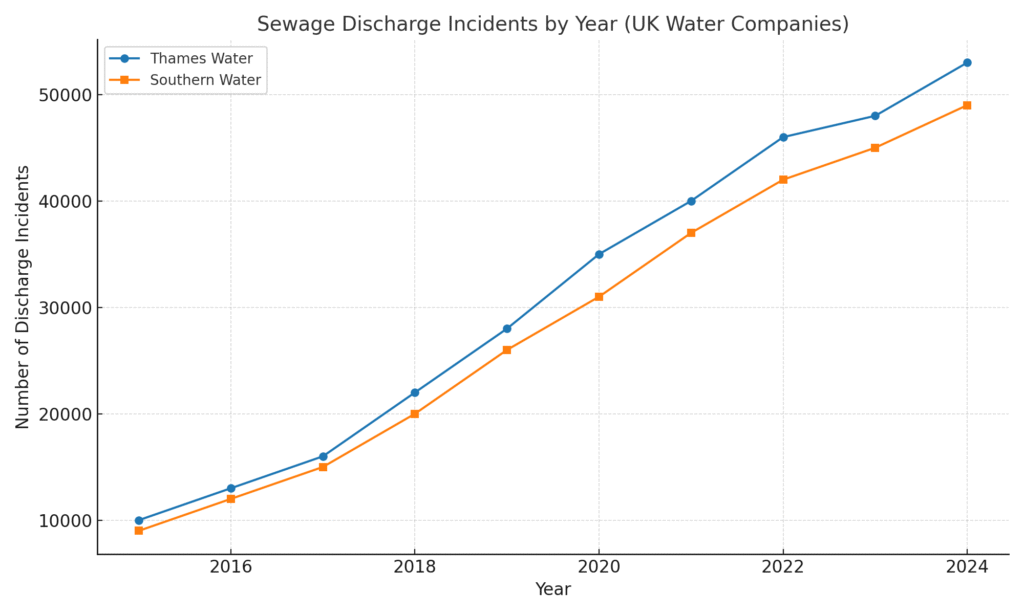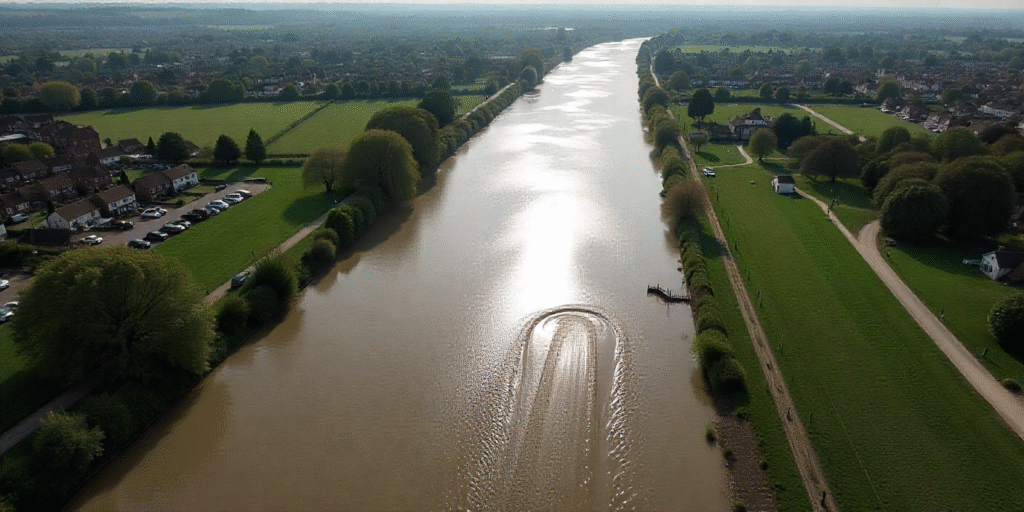A Crisis Hidden in Plain Sight
Earlier this month, UK environmental authorities and independent journalists exposed something shocking: England’s water companies have been illegally discharging raw sewage even when there’s no rainfall. This isn’t a rare accident—it’s happening over 100 times every single day, according to a report by The Times.
Normally, sewage overflows are only allowed during wet weather, when stormwater overwhelms old sewer systems. But these “dry spill” events—where untreated human waste is released into rivers and coastal waters on sunny, rain-free days—violate environmental permits and put both public health and ecosystems at risk.
Even more disturbing, many of these discharges are happening near protected nature reserves and public swimming areas, causing massive outrage.
What’s Really Going On?
At the heart of the issue is England’s century-old sewer infrastructure, which was simply never built to handle modern waste loads or rising populations.
The UK’s privatized water firms—like Thames Water and Southern Water—are under intense scrutiny for failing to invest in system upgrades. Instead, these companies have paid out billions in dividends to shareholders, all while the nation’s rivers have steadily declined in quality. A 2023 BBC investigation uncovered how company profits ballooned while investment in critical sewage systems lagged behind.
The system is stretched, yes—but that’s no excuse. These dry-weather spills suggest either gross negligence or intentional cost-cutting, both of which are completely unacceptable in one of the world’s wealthiest countries.

Health and Environmental Fallout
Let’s be clear: raw sewage is toxic. It carries E. coli, coliform bacteria, viruses, microplastics, and even leftover pharmaceuticals. Dumping it into rivers and coastal waters:
- Poses serious health risks to swimmers, surfers, and local residents
- Destroys aquatic biodiversity, disrupting natural ecosystems
- Contaminates fish and shellfish with bioaccumulative toxins
Take the River Wye as an example. Once known for its pristine beauty and fly fishing, it’s now a textbook case of ecological collapse. Conservationists say its condition is the worst in living memory—largely due to repeated sewage spills and agricultural runoff.
Citizens and Communities Are Angry
People are fed up—and they’re making noise. Across England, communities have begun tracking water quality in real time. Apps and websites now warn swimmers when it’s unsafe to go into the water. Campaigns like Surfers Against Sewage are mobilizing activists, and lawsuits are mounting.
In response, the UK government has announced a £104 billion plan to upgrade the country’s water infrastructure by 2030. This would include:
- Replacing aging pipes and treatment facilities
- Installing real-time sewage monitoring systems
- Penalizing illegal discharges more harshly
- Improving public transparency around pollution events
Still, many experts believe these moves are too slow—and may even be a PR move to silence criticism rather than a meaningful shift.
This Isn’t Just England’s Problem
You might be thinking, “This is bad, but it’s a local issue. What’s it got to do with us?”
Actually—everything.
What’s happening in England is just the tip of the iceberg. The world over, nations are dealing with underfunded water infrastructure, regulatory gaps, and worsening pollution.
Developing Nations
In India, Bangladesh, and many African nations, sewage treatment facilities are lacking or overwhelmed. Major rivers like the Ganges and Nile receive untreated waste daily. The key difference? There, the problem is visible and acknowledged. In England, it was hidden until now.
The United States
Even in the U.S., combined sewer overflows (CSOs) are a huge concern. In older cities like New York, Chicago, and St. Louis, sewage systems still combine rainwater and waste, meaning heavy rainfall often leads to raw waste pouring into local rivers and lakes. The U.S. Environmental Protection Agency (EPA) estimates over 850 billion gallons of sewage are discharged this way every year.
Iran’s “Water Bankruptcy”
On the other side of the spectrum, countries like Iran face a water scarcity crisis. Years of over-extraction and poor planning have pushed cities like Tehran toward what experts call “Day Zero”, when the taps might simply run dry.
The lesson here? Whether it’s too much sewage or not enough water, we are all living through a water crisis—one way or another.
What Genviss Believes: Our Approach
At Genviss, we see this as more than just a news story—it’s a call to action.
Water is not just a utility. It’s a human right, a resource that underpins every aspect of life. And yet, it continues to be treated with negligence, even in so-called developed countries.
Here’s what we stand for:
Smart Water Monitoring
We believe in using IoT-based sensors, AI-powered alerts, and predictive analytics to detect sewage risks before they happen. Prevention always beats cleanup.
Decentralized Treatment Units
Instead of relying solely on massive central plants, smaller, localized treatment systems can treat wastewater on-site and reduce the load on main networks. They’re faster to deploy, easier to maintain, and often more sustainable.
Transparency and Public Access
The public should always know the status of their water. Open dashboards, alerts, and mobile apps can empower communities to hold polluters accountable.
Strict Penalties for Polluters
Without strict fines and criminal accountability, companies will continue to cut corners. Strong enforcement is key to changing behavior.
Educating the Public
People must understand that what goes down the drain doesn’t disappear. Awareness around proper waste disposal (like avoiding flushing wipes and chemicals) can make a big difference.
Final Thoughts: A Global Wake-Up Call
England’s sewage scandal isn’t just a local embarrassment—it’s a global warning sign. It shows what happens when maintenance is ignored, oversight is weak, and profit takes priority over public health.
From London to Los Angeles, Mumbai to Tehran, we must ask ourselves: Are we treating our water infrastructure with the urgency it deserves?
Because without clean water, there is no health.
No business.
No future.
Let’s take this moment to rethink, reinvest, and reimagine how we care for the most vital resource on Earth.
Want to learn more about how Genviss is driving smart water safety across industries? Visit us at genviss.in.

